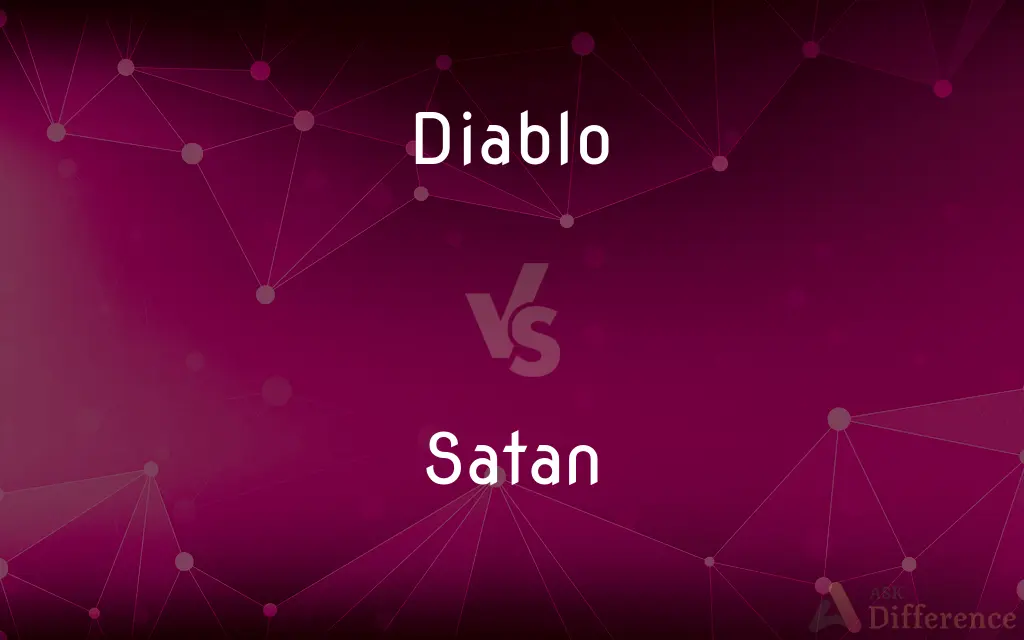Diablo vs. Satan — What's the Difference?
By Maham Liaqat & Urooj Arif — Updated on March 31, 2024
Diablo is the Spanish word for "devil", often used in English to refer to Satan or evil entities, while Satan is a biblical figure symbolizing evil and temptation in Christian theology.

Difference Between Diablo and Satan
Table of Contents
ADVERTISEMENT
Key Differences
Diablo originates from the Latin word "diabolus", which itself is derived from Greek, meaning "slanderer" or "accuser". It's a term used broadly to denote the devil in Spanish-speaking cultures and by English speakers to reference devilish or demonic aspects in various contexts, including literature and entertainment. Satan, on the other hand, is a specific entity in Judeo-Christian religions, regarded as the ultimate embodiment of evil, opposition, and temptation against God and humanity.
While "Diablo" can be used to describe devilish qualities or infernal beings in general, "Satan" specifically refers to the fallen angel who rebels against God according to Christian belief. This distinction highlights the broader use of Diablo in describing evil or the devilish, as opposed to the more defined theological role Satan plays in religious texts.
In popular culture, Diablo is often used as a name or title for characters, games, or movies that wish to evoke a dark, menacing, or evil quality. "Satan" is used in religious and cultural contexts to represent the personification of ultimate evil and adversary of God, often invoked in discussions of morality, sin, and temptation.
The concept of Diablo encompasses a wide range of devilish figures across different cultures, reflecting the universal theme of a malevolent force opposing good. Satan, while also serving as a universal symbol of evil in many cultures, has specific narrative and theological roles within the texts and teachings of Judeo-Christian religions.
Comparison Chart
Origin
Latin "diabolus", meaning slanderer or accuser
Hebrew "Satan", meaning adversary or accuser
ADVERTISEMENT
Usage
Broad, can refer to any devilish or demonic entity
Specific, refers to the biblical figure opposing God
Cultural Context
Used widely in Spanish-speaking cultures and by English speakers in various contexts
Central to Judeo-Christian theology as the embodiment of evil
Role in Religion
General term for the devil
The principal antagonist of God and humanity in Christianity
Popular Culture
Commonly used to name characters or elements in games and media that embody evil
Represents the ultimate evil and temptation, often depicted in literature, movies, and art
Compare with Definitions
Diablo
A term used to denote the devil or an evil spirit in Spanish-speaking cultures.
The story featured a battle between a brave knight and Diablo.
Satan
The chief antagonist in Christian theology, embodying evil and opposition to God.
Satan tempts humans to stray from the path of righteousness.
Diablo
In English, it can refer to anything characterized by devilish qualities.
The diablo sauce was so hot it felt like it came from hell itself.
Satan
Often represented in art and literature as the personification of ultimate evil.
Dante's Inferno depicts Satan trapped in the frozen lake at hell's center.
Diablo
Represents malevolent forces in folklore and mythology.
In many tales, heroes face off against diablos or demons.
Satan
Depicted as a fallen angel in biblical texts, rebelling against God.
Satan's fall from grace is a story of pride and rebellion.
Diablo
Name used in entertainment to evoke darkness or evil.
Diablo is a popular video game series centered around battling the forces of hell.
Satan
Symbolizes temptation and the moral challenges faced by individuals.
The concept of Satan challenges believers to resist evil temptations.
Diablo
Can describe someone with mischievous or rebellious qualities.
He was known as el Diablo for his cunning and daring escapades.
Satan
Invoked in discussions on morality, sin, and redemption.
Theological debates often explore the influence of Satan in human affairs.
Diablo
Diable.
Satan
Satan, also known as the Devil, and sometimes also called Lucifer in Christianity, is a non-physical entity in the Abrahamic religions that seduces humans into sin or falsehood. In Judaism, Satan is seen as an agent subservient to God or typically regarded as a metaphor for the yetzer hara, or "evil inclination".
Diablo
(Southwest US) the devil
Satan
In Abrahamic religions, a powerful spiritual being, the tempter and persecutor of humanity, sometimes considered as an angel who rebelled against God and became the Devil.
Diablo
Diable, flavoured with hot spices
Satan
Alternative form of Satan.
Satan
The grand adversary of man; the Devil, or Prince of darkness; the chief of the fallen angels; the archfiend.
I beheld Satan as lightning fall from heaven.
Satan
(Judeo-Christian and Islamic religions) chief spirit of evil and adversary of God; tempter of mankind; master of Hell
Common Curiosities
Is Diablo the same as Satan?
While Diablo can refer to Satan, it's a broader term that can denote any devilish entity, not just the biblical Satan.
Can the term Diablo be used interchangeably with Satan?
In many contexts, yes, especially when referring to the concept of evil or the devil in a broad sense. However, Satan has specific theological implications.
Why is Satan important in Christian theology?
Satan represents the embodiment of evil and temptation, serving as a test of faith and morality for humans.
How do cultural perceptions of Diablo and Satan differ?
Cultural perceptions vary, with Diablo often seen in a more general sense of evil or mischief, while Satan carries significant religious and moral connotations.
What role does Satan play in religious texts?
Satan is depicted as the ultimate adversary of God and humanity, tempting individuals away from righteousness and towards sin.
What is the role of Satan in the story of human temptation?
Satan is often portrayed as the tempter, challenging individuals' faith and morality by presenting them with choices that lead away from divine law.
What impact does the belief in Diablo or Satan have on society?
These beliefs influence cultural narratives about morality, ethics, and the nature of evil, affecting everything from art and literature to religious practices and societal norms.
How has the concept of Diablo evolved over time?
The concept of Diablo has expanded beyond religious texts to encompass a wide range of representations of evil or mischievous spirits in folklore, literature, and media.
Are there different interpretations of Satan across religions?
Yes, interpretations of Satan vary, from a literal being opposing God to a metaphorical representation of human vice or the internal struggle against sin.
How are Diablo and Satan used in modern storytelling?
They are used as archetypes representing various aspects of evil, conflict, and the human condition, often driving plots in literature, film, and video games.
What is the significance of Satan in literature and art?
Satan is a complex figure symbolizing rebellion, temptation, and the struggle between good and evil, explored in various cultural, religious, and philosophical contexts.
How do depictions of Diablo and Satan vary in different cultures?
Depictions vary widely, with Diablo encompassing a range of evil spirits in folklore and mythology, while Satan's portrayal is more consistent, rooted in Judeo-Christian traditions.
How is Diablo depicted in popular culture?
Diablo is often used to name or describe characters, places, or scenarios associated with evil, darkness, or supernatural horror.
Can someone be called a Diablo?
Yes, calling someone a Diablo can imply they are mischievous, rebellious, or embody devilish characteristics, often used in a playful or affectionate manner.
Why do some people wear symbols of Diablo or Satan?
Wearing these symbols can signify rebellion, a fascination with the occult, or a philosophical statement against conventional morality or religious beliefs.
Share Your Discovery

Previous Comparison
Segmental vs. Suprasegmental
Next Comparison
Chirrup vs. WhistleAuthor Spotlight
Written by
Maham LiaqatCo-written by
Urooj ArifUrooj is a skilled content writer at Ask Difference, known for her exceptional ability to simplify complex topics into engaging and informative content. With a passion for research and a flair for clear, concise writing, she consistently delivers articles that resonate with our diverse audience.














































